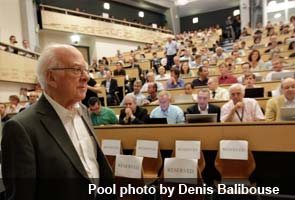 Aspen (Colorado): Physicists working at CERN's Large Hadron Collider said today that they had discovered a new particle that looks for all the world like the Higgs boson, a long sought particle that is a key to understanding why elementary particles have mass and indeed to the existence of diversity and life in the universe.
Aspen (Colorado): Physicists working at CERN's Large Hadron Collider said today that they had discovered a new particle that looks for all the world like the Higgs boson, a long sought particle that is a key to understanding why elementary particles have mass and indeed to the existence of diversity and life in the universe."I think we have it," said Rolf Heuer, the Director General of CERN in an interview from his office outside of Geneva. His words signaled what is probably the beginning of the end of the longest most expensive manhunt in the history of science and, if scientists are lucky, could lead to a new understanding of how the universe began.
Dr Heuer and others said that it was too soon to know for sure whether the new particle, which weighs in at 125 billion electron volts, the heaviest subatomic particle yet, fits the simplest description given by the Standard Model, the theory that has ruled physics for the last half century, or whether it is an imposter, a single particle or even the first of many. The latter possibilities are particularly exciting to physicists since they could point the way to new deeper ideas, beyond the Standard Model, about the nature of reality.
Joe Incandela, of the University of California, Santa Barbara, and spokesperson for one of two groups reporting data, Wednesday called the discovery, " very, very significant. It's something that may, in the end, be one of the biggest observations of any new phenomena in our field in the last 30 or 40 years, going way back to the discovery of quarks, for example."
Here at the Aspen Center for Physics, a retreat for scientists that will celebrate its 50th birthday Saturday, bleary-eyed physicists watched their colleagues read off the results in a webcast from CERN. That was a scene that was duplicated in Melbourne, Australia, where physicists had gathered for a major conference, to Los Angeles to Chicago to Princeton, New York City, London, and beyond, everywhere that members of a curious species have dedicated their lives and fortunes to the search for their origins in a dark universe.
No comments:
Post a Comment